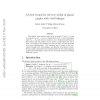193 search results - page 10 / 39 » A Lower Bound for the Shortest Path Problem |
134
click to vote
WINE
2010
Springer
14 years 9 months ago
2010
Springer
We consider the Stackelberg shortest-path pricing problem, which is defined as follows. Given a graph G with fixed-cost and pricable edges and two distinct vertices s and t, we may...
CORR
2010
Springer
14 years 11 months ago
2010
Springer
The disjoint paths problem asks, given an graph G and k + 1 pairs of terminals (s0, t0), . . . , (sk, tk), whether there are k + 1 pairwise disjoint paths P0, . . . , Pk, such tha...
82
Voted
SWAT
1998
Springer
15 years 3 months ago
1998
Springer
Given an alphabet , a (directed) graph G whose edges are weighted and -labeled, and a formal language L , the formal-language-constrained shortest/simple path problem consists of ...
STACS
2010
Springer
15 years 6 months ago
2010
Springer
Reachability and shortest path problems are NL-complete for general graphs. They are known to be in L for graphs of tree-width 2 [14]. However, for graphs of treewidth larger than ...
CIKM
2009
Springer
15 years 6 months ago
2009
Springer
In this paper we study approximate landmark-based methods for point-to-point distance estimation in very large networks. These methods involve selecting a subset of nodes as landm...


